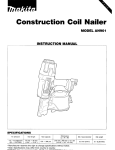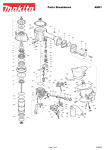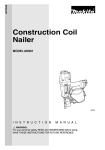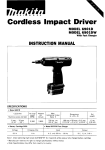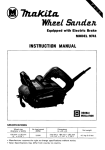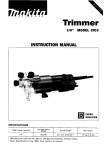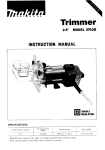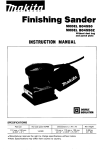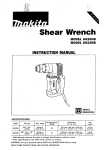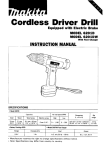Download Makita AN8300 Instruction manual
Transcript
Pneumatic Framing Nailer MODEL AN8300 INSTRUCTION MANUAL Air pressure Nail length 4.2 8.5 kgf1cmZG (60 - 120 PSIG) 51 mm - 90 mm (2" - 3-112") ~ Nail capacity 64 - 74 pes, IL x H x W l Dimensions Min hose diameter Net weight 5 4 4 m m x 3 4 9 m m x 112mm (21-13132" x 13-314" x 4-13/32',) 8.5 mm (11132") 3.6 kg (7.9 lbsl * Manufacturer reserves the right to change specifications without notice. *Note: Specifications may differ from country to country. *3-1/2" nail: Use for soft workpieces only. IMPORTANT SAFETY TOOL USE INSTRUCTIONS WARNING: WHEN USING THIS TOOL, BASIC SAFETY PRECAUTIONS SHOULD ALWAYS BE FOLLOWED TO REDUCE THE RISK OF PERSONAL INJURY, INCLUDING THE FOLLOWING: READ ALL INSTRUCTIONS. For personal safety and proper operation and maintenance of the tool, read this instruction manual carefully before using the tool. Wear light but not loose clothing. Sleeves should be buttoned or rolled up. No necktie should be worn. *Always wear safety glasses to protect your eyes from dust or nail injury. The safety glasses should conform with the requirements of ANSI 287. 1 1979. Also wear hearing protection to protect your ears against exhaust noise. WARN ING : It is an employer's responsibility t o enforce the use of safety eye protection equipment by the tool operators and by other persons in the immediate working area. *Rushing the job or forcing the tool is dangerous. Handle the tool carefully. Do not operate when under the influence of alcohol, drugs or the like. General Tool Handling Guidelines: I 1.Always assume that the tool contains fasteners. 2. Do not point the tool toward yourself or anyone whether it contains fasteners or not. 3.Never depress the operating control unless the nosepiece of the tool is directed toward the workpiece. 4. Respect the tool as a working implement. 5. No horseplay. 6. Do not transport the tool with the operating control depressed. 7. Do not load the tool with fasteners with the work-contacting element or operating con trol depressed. Sparks sometimes fly when the tool is used. Do not use the tool near volatile, flammable materials such as gasoline, thinner, paint, gas, adhesives, etc.; they will ignite and explode, causing serious injury. W The area should be sufficiently illuminated t o assure safe operations. The area should be clear and litter- free. Be especially careful t o maintain good footing and balance. *Only those involved in the work should be in the There may be local regulations concerning noise which must be complied with by keeping noise levels within prescribed limits. In certain cases, shutters should be used to contain noise. I Shutter Do not tamper with the tool or attempt t o use it for other than nailing. Do not play with the contact arm; it prevents accidental discharge, so it must be kept on and not removed. Securing the trigger in the ON position is also very dangerous. Never attempt to fasten the trigger. Trigger Contact arm Operate the tool within the specified air pressure of 4.2 - 8.5 kgf/cm’G (60 - 120 PSIG) for safety and longer tool life. The tool should not be connected to a source whose pressure potentially exceeds 14.0 kgf/cm’G (200 PSIG). Never use the tool with other than compressed air. If high-pressure gas (propane, acetylene, oxygen, etc.) is used as a Dower source for this tool, the tool 120 PS1.G 120 PSIG Always check the tool for its overall condition and loose screws before operation. Tighten as required. Make sure all safety systems are in working order before operation. The tool must not operate if only the trigger is pulled or if only the contact arm is pressed against the wood. It must work only when both actions are performed. Test for possible faulty operation with nails unloaded and with the pusher locked at fully pulled position. Pusher / Pusher @Checkwalls, ceilings, floors, roofing and the like carefully to avoid possible electrical shock, gas leakage, explosions, etc. caused by striking lives wires, conduits or gas pipes. Live wire I Use only nails specified in this manual. The use of any other nails may cause malfunction of the tool. Do not permit those uninstructed t o use the tool. .Make sure no one is nearby before nailing. Never attempt t o nail from both the inside and outside at the same time. Nails may rip through and/or fly off, presenting a grave danger. Watch your footing and maintain your balance with the tool. Make sure there is no one below when working in high locations, and secure the air hose t o prevent danger if there is sudden jerking or catching. 2 On rooftops and other high locations, nail as you move forward. It is easy t o lose your footing if you nail while inching backward. When nailing against perpendicular surface, nail from the top t o the bottom. You can perform nailing operations with less fatigue by doing so. A nail will be bent or the tool can become jammed if you mistakenly nail on top of another nail or strike a knot in the wood. The nail may be thrown and hit someone, or the tool itself can react dangerously. Place the nails with care. Hold the workpiece securely. Under nailer impact, the workpiece can fly about dangerously if not held securely in place. Do not leave the loaded tool or the air compressor under pressure for a long time out in the sun. Be sure that dust, sand, chips and foreign matter will not enter the tool in the place where you leave it setting. .Do not point the ejection port at anyone in the vicinity. Keep hands and feet away from the ejection port area. *When the air hose is connected, do not carry the tool with your finger on the trigger or hand it to someone in this condition. Accidental firing can be extremely dangerous. Handle the tool carefully as there is high pressure inside the tool that can be dangerous if a crack is caused by rough handling (dropping or striking). Do not attempt t o carve or engrave on the tool. Stop nailing operations immediately if you notice something wrong or out of the ordinary with the tool. Always disconnect the air hose and remove all of the nails before inspection, maintenance, relocating, or after operation is over. Perform cleaning and maintenance right after finishing the job. Keep the tool in tip-top condition. Lubricate moving parts t o prevent rusting and minimize friction related wear. Wipe off all dust from the parts. Ask Makita's Factory or Authorized service center for periodical inspection of the tool. SAVE THESE INSTRUCTIONS. TOOL INSTALLATION INSTRUCTIONS AND USE Lubrication To insure maximum performance, install the air set (oiler, regulator, air filter) as close as possible t o the tool. Adjust the oiler so that one drop of oil will be provided for every 30 nails. When the air set oiler is not used, oil with a few drops of turbine oil through the air plug both before and after nailing operations. Simply oil before use, but when oiling after use, operate the tool several times to assure good lubrication. This makes certain the oil works into and throughout the tool t o prevent rusting. When using the tool for a long time, oil during nailing operations. Loading nailer CAUTION: Always disconnect the air hose before loading the nails into the nailer Pull the pusher until i t is locked by the lock lever. I I Pusher I Insert strip of nails into the magazine. Two strips of nails can be loaded a t a time. Make sure that when loading the second strip the first nail of the second strip sets on (overlaps) the last nail of the first strip. While pulling the pusher, press the lock lever to unlock the pusher. Then return the pusher while pressing the lock lever. Lock lever I I Selecting compressor w The air compressor shall comply with the requirements ._2 200 E of ANSI 519.3 - 1981. 150 Select a compressor that has ample high pressure and 3 air output in order to assure cost-efficient operation. a 100 The tool should not be connected to a source whose ._ pressure potentially exceeds 14.0kgf/cm2 G (200 PSIG). ," 50 2 The graph a t right shows the relation between nailing E! frequency, applicable pressure and compressor air out= a 30 40 60 80 100 5 put. Thus, for example, if the nailing takes place a t a (times/min.) V Nailing frequency speed of approximately 60 times per minute a t a compression of 5 kgf/cm*G (70 PSIG), a compressor with an air output over 80 Iiterdminute is required. Pressure regulators shall be used t o limit air pressure to the rated pressure of the tool where air supply pressure exceeds the tool's rated pressure. L t-' 2 L Use an air hose as thick and as short as possible to assure continuous, efficient nailing operations. With an air pressure of 5 kgf/cm2 G (70 PSIG), an air hose with an internal diameter of over 8.5 mm ( 1 1/32")and a length of less than 20 m (6.6 f t . ) is recommended when the interval between each nailing is 0.5 seconds. Air supply hoses shall have a minimum working pressure rating of 10.7 kgf/cm2G (150 PSIG) or 150 percent of the maximum pressure produced in the system whichever is higher. CAUTION: Low air output of the compressor, or a long or thin air hose in relation to the nailinq frequency may cause a decrease in the driving force Connecting air hose Slip the air socket of the air hose onto the air plug on the nailer. Be sure that the air socket locks firmly into position when installed onto the air plug. A hose coupling must be installed on or near the tool in such a way that the pressure reservoir will discharge a t the time the air supply coupling is disconnected, Air plug Operation 1)To drive a nail, you may place the contact arm against the workpiece and pull the trigger, or 2) Pull the trigger first and then place the contact arm against the workpiece. I Trigger ._ I No, 1 method is for intermittent nailing, when you wish to drive a nail carefully and very accurately. No. 2 method is for continuous nailing. When the nailer becomes jammed, do as follows: First, disconnect the air hose. Remove the strip of nails. Insert a small rod or the like into the ejection port and tap it with a hammer to retract the driver. Use pliers to bend the jammed nail so that the nail head comes out of the slot in the driver guide. Then remove the jammed nail. Contact arm I 1 I 1 Workpiece Workpiece Hammer Nails Handle nail strips and their box carefully. If the nail strips have been handled roughly, they may be out of shape or their connector breaks, causing poor nail feed. Avoid storing nails in a very humid or hot place or place exposed to direct sunlight. MAINTENANCE CAUTION: Always be sure that the air hose is disconnected from the tool before attempting to perform inspection or maintenance Maintenance of nailer Always check the tool for its overall condition and loose screws before operation. Tighten as required. Make sure all safety systems are in working order before operation. The tool must not operate if only the trigger is pulled or if only the contact arm is pressed against the wood. I t must work only when both actions are performed. Test for possible faulty operation with nails unloaded and with the pusher locked a t fully pulled position. Pusher Pusher When not using the tool for a long period, coat metal parts lightly with machine oil to prevent rust. Avoid storing the tool in a very humid or hot place or place exposed to direct sunlight. I Maintenance of compressor, air set and air hose After operation, always drain the compressor tank and the air filter. If the tool is used without the water thus drained, poor performance and a possible breakdown can result. I Drain cock Air filter \ Check regularly t o see if there is sufficient turbine oil in the oiler of the air set. Failure to have sufficient lube will cause fast O-ring wear, when the tool is used. I Turbine oil Keep the air hose away from heat (over 60°C, over 140" F), chemicals (thinner, strong acids or alkalis) and possible damage. To maintain product SAFETY and RELIABILITY, maintenance and repairs should be performed by Makita Authorized or Factory Service Centers, always using Makita replacement Darts. (MEMO) MAKITA LIMITED ONE YEAR WARRANTY Warranty Policy Every Makita tool is thoroughly inspected and tested before leaving the factory. It is warranted to be free of defects from workmanship and materials for the period of ONE YEAR from the date of original purchase. Should any trouble develop during this one-year period, return the COMPLETE tool, freight prepaid, to one of Makita’s Factory or Authorized Service Centers. If inspection shows the trouble is caused by defective workmanship or material, Makita will repair (or at our option, replace) without charge. This Warranty does not apply where: repairs have been made or attempted by others: repairs are required because of normal wear and tear: The tool has been abused, misused or improperly maintained ; alterations have been made to the tool. IN NO EVENT SHALL MAKITA BE LIABLE FOR ANY INDIRECT, INCIDENTAL OR CONSEQUENTIAL DAMAGES FROM THE SALE OR USE OF THE PRODUCT. THIS DISCLAIMER APPLIES BOTH DURING AND AFTER THE TERM OF THIS WARRANTY. MAKITA DISCLAIMS LIABILITY FOR ANY IMPLIED WARRANTIES, INCLUDING IMPLIED WARRANTIES OF “MERCHANTABILITY” AND “FITNESS FOR A SPECIFIC PURPOSE,” AFTER THE ONE-YEAR TERM OF THIS WARRANTY. This Warranty gives you specific legal rights, and you may also have other rights which vary from state to state. Some states do not allow the exclusion or limitation of incidental or consequential damages, so the above limitation or exclusion may not apply to you. Some states do not allow limitation on how long an implied warranty lasts, so the above limitation may not apply to you. Makita Corporation 3-11-8, Sumiyoshi-cho, Anjo, Aichi 446 Japan 883750B062 PRINTED IN JAPAN l Q Q 7- R - N
















